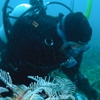General Description
Colony of individual polyps (hydranths) joined by root-like network of tubular stolons at the base. Colony shape is single stems. Colour: purplish-brown. Up to 5 cm high.
Biology
Colonies of this species grow throughout the year, and are fertile in spring to late summer.
Habitat
Among holdfasts of seaweed and on sponge in sheltered oceanic waters.
Reefs
Distribution guide
New Zealand and southern Australia.
Species Group
Depth
Water Column
Max Size
5 cm
Diet
Plankton or Particles
Harmful
Generally not harmful but still able to sting bare skin.
Commercial Species
No
Global Dispersal
Recorded in Australia
Identify
Conservation Status
- DSE Advisory List : Not listed
- EPBC Act 1999 : Not listed
- IUCN Red List : Not listed





